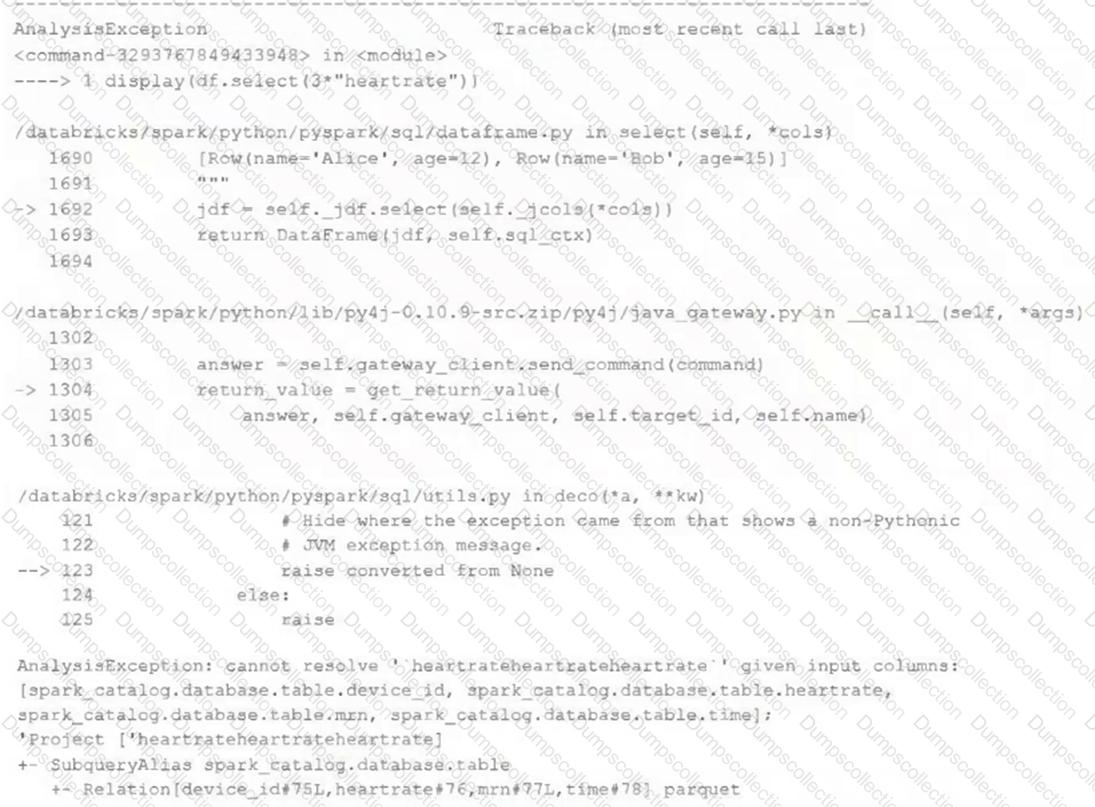Databricks Databricks Certified Data Engineer Professional Exam Databricks-Certified-Professional-Data-Engineer Exam Dumps: Updated Questions & Answers (December 2025)
Which of the following technologies can be used to identify key areas of text when parsing Spark Driver log4j output?
The DevOps team has configured a production workload as a collection of notebooks scheduled to run daily using the Jobs Ul. A new data engineering hire is onboarding to the team and has requested access to one of these notebooks to review the production logic.
What are the maximum notebook permissions that can be granted to the user without allowing accidental changes to production code or data?
Given the following error traceback (from display(df.select(3*"heartrate"))) which shows AnalysisException: cannot resolve 'heartrateheartrateheartrate', which statement describes the error being raised?
A user new to Databricks is trying to troubleshoot long execution times for some pipeline logic they are working on. Presently, the user is executing code cell-by-cell, using display() calls to confirm code is producing the logically correct results as new transformations are added to an operation. To get a measure of average time to execute, the user is running each cell multiple times interactively.
Which of the following adjustments will get a more accurate measure of how code is likely to perform in production?
A Delta Lake table with Change Data Feed (CDF) enabled in the Lakehouse named customer_churn_params is used in churn prediction by the machine learning team. The table contains information about customers derived from a number of upstream sources. Currently, the data engineering team populates this table nightly by overwriting the table with the current valid values derived from upstream data sources. The churn prediction model used by the ML team is fairly stable in production. The team is only interested in making predictions on records that have changed in the past 24 hours. Which approach would simplify the identification of these changed records?
A distributed team of data analysts share computing resources on an interactive cluster with autoscaling configured. In order to better manage costs and query throughput, the workspace administrator is hoping to evaluate whether cluster upscaling is caused by many concurrent users or resource-intensive queries.
In which location can one review the timeline for cluster resizing events?
A Structured Streaming job deployed to production has been resulting in higher than expected cloud storage costs. At present, during normal execution, each micro-batch of data is processed in less than 3 seconds; at least 12 times per minute, a micro-batch is processed that contains 0 records. The streaming write was configured using the default trigger settings. The production job is currently scheduled alongside many other Databricks jobs in a workspace with instance pools provisioned to reduce start-up time for jobs with batch execution. Holding all other variables constant and assuming records need to be processed in less than 10 minutes, which adjustment will meet the requirement?
A junior data engineer is migrating a workload from a relational database system to the Databricks Lakehouse. The source system uses a star schema, leveraging foreign key constrains and multi-table inserts to validate records on write.
Which consideration will impact the decisions made by the engineer while migrating this workload?
Review the following error traceback:

Which statement describes the error being raised?
The Databricks workspace administrator has configured interactive clusters for each of the data engineering groups. To control costs, clusters are set to terminate after 30 minutes of inactivity. Each user should be able to execute workloads against their assigned clusters at any time of the day.
Assuming users have been added to a workspace but not granted any permissions, which of the following describes the minimal permissions a user would need to start and attach to an already configured cluster.

